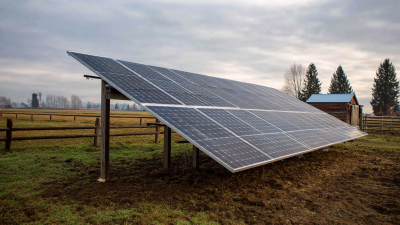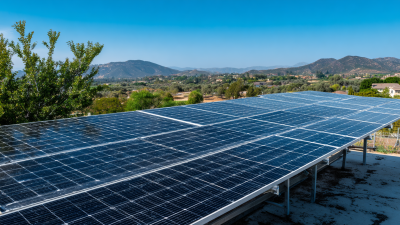Blog
How to Maximize Your Savings with a 6.6 kW Solar System for Residential Use
As the demand for renewable energy continues to rise, many homeowners are considering the installation of solar panels to reduce their electricity bills and minimize their carbon footprint. A 6.6 kW solar system has emerged as one of the most popular choices for residential use, as it offers an optimal balance between energy production and installation costs. According to the Solar Energy Industries Association, the average residential solar system size in the United States is around 6 kW, and a well-installed 6.6 kW system can generate approximately 8,000 to 10,000 kilowatt-hours of electricity per year, depending on location and sunlight exposure. This allows homeowners not only to maximize their savings on utility bills but also to take advantage of various tax incentives and rebates. By adopting solar energy, households can significantly decrease their reliance on fossil fuels while contributing to a more sustainable environment.

Understanding a 6.6 kW Solar System and Its Benefits for Homeowners
A 6.6 kW solar system is an excellent investment for homeowners looking to reduce energy costs and minimize their carbon footprint. This system typically comprises 18-22 solar panels, depending on the wattage of each panel, and can generate a significant amount of electricity to power your home. Understanding how this system works and its benefits enables homeowners to make informed decisions, unlocking substantial savings in the long run.
One of the primary benefits of a 6.6 kW solar system is the potential for significant savings on electricity bills. By producing your own energy, homeowners can reduce reliance on the grid and avoid fluctuating energy prices. Additionally, many regions offer incentives such as tax credits or rebates for solar installation, further enhancing the financial benefits.
Tips for maximizing your savings include conducting an energy audit before installation to understand your household's energy needs better. It’s also beneficial to monitor your energy consumption and production regularly, which can help identify patterns and areas for improvement. Lastly, consider scheduling your energy-intensive tasks during peak solar production hours to efficiently use the energy generated by your solar system.
Maximizing Savings with a 6.6 kW Solar System
Key Factors to Consider When Choosing a Solar System for Your Home
When considering a 6.6 kW solar system for residential use, there are several key factors to keep in mind to maximize your savings. First, it's essential to assess your energy consumption. According to the U.S. Energy Information Administration, the average American household consumes about 877 kWh per month. A 6.6 kW solar system can produce an average of 850 to 1,000 kWh per month, making it ideal for most households looking to cover their monthly energy needs and reduce electricity bills.
The orientation and angle of your solar panels also play a crucial role in their efficiency and energy output. A system installed on a south-facing roof at an angle of 30 degrees can generate approximately 20% more energy compared to a flat roof installation. Furthermore, considering local climate conditions is essential, as reports from the National Renewable Energy Laboratory reveal that solar panels typically generate 80-90% of their rated output in optimal conditions. Therefore, thorough site assessments and understanding regional solar potential can significantly enhance the effectiveness of a solar investment, leading to increased savings over time.
How a 6.6 kW Solar System Can Reduce Your Electricity Bills
With recent electricity price hikes of 20–30% impacting households, many residents are turning to solar energy solutions to help manage their costs. A 6.6 kW solar system can play a crucial role in reducing electricity bills, as it harnesses solar power to minimize reliance on the grid. By generating a significant amount of energy, homeowners can offset their purchasing from the utility company, leading to substantial savings over time. With the average installation taking less than ten years to pay for itself, the financial benefits are evident.
Moreover, the integration of battery systems with solar setups is becoming increasingly attractive, particularly in regions like New South Wales, where grid prices are on the rise. Batteries allow homeowners to store excess solar energy generated during the day for use during peak hours when electricity prices are highest. This not only maximizes savings but also enhances energy independence, making it a smart investment for the future. As solar technology continues to advance, now is an opportune time for homeowners to explore installation options that suit their needs and take control of their energy expenditure.
Incentives and Rebates for Installing a Solar System in Your Area
When considering the installation of a 6.6 kW solar system for residential use, it's essential to explore the various incentives and rebates available in your area. Many governments and local authorities provide financial incentives to encourage homeowners to adopt renewable energy solutions. These can significantly offset the initial costs of installing solar panels, making the transition to solar energy more accessible and financially viable for many families.
Tax credits, such as the federal solar investment tax credit (ITC), allow homeowners to deduct a percentage of their solar system installation costs from their federal taxes. Additionally, certain states and municipalities offer direct rebates that can further reduce upfront expenses. Some utility companies also provide incentives, such as net metering programs, that credit homeowners for the excess electricity their solar systems generate. Being well-informed about these programs can help you maximize your savings and decrease the payback period for your investment in solar energy.

Maintaining Your Solar System for Long-Term Savings and Efficiency
Maintaining your 6.6 kW solar system is crucial for ensuring long-term savings and optimal efficiency. Regular maintenance can significantly impact the overall performance and lifespan of your system. According to the Solar Energy Industries Association (SEIA), systems that are well-maintained can operate at 10-15% higher efficiency over time. Simple tasks like cleaning the panels, checking for shading issues, and ensuring the inverter is functioning properly can make a substantial difference in energy output.
In addition to routine checks, investing in professional inspections every few years can unveil potential issues before they escalate. A report from NREL (National Renewable Energy Laboratory) highlighted that proactive maintenance can increase solar system longevity, sometimes extending warranties beyond their standard duration. With solar energy generation being a long-term investment, these practices not only safeguard your system but also enhance the value of your property, potentially adding up to 4.1% to your home’s resale value, as indicated by a Stanford University study. By keeping your 6.6 kW solar system well-maintained, you set the stage for long-lasting savings and energy efficiency.

Related Posts
-

7 Compelling Reasons to Start DIY Solar Panels for Your Home in 2023
-

Essential Checklist for Installing Roof Solar Panels to Maximize Energy Efficiency
-

Innovative DIY Solar System Ideas Transforming Renewable Energy Accessibility
-

Challenges Faced with 400 Watt Solar Panel Installation
-

The Future of Sustainable Living with DIY Solar Systems
-

Emerging Trends in Solar Energy for the Best Solar Panels by 2025

